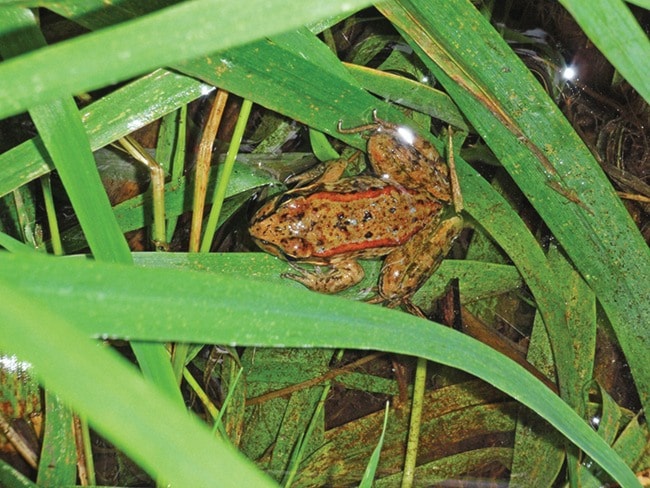While they certainly are making a ruckus up at the John Hart Dam Project, they are also trying to minimize their environmental impact in whatever ways they can, according to spokesperson for the project Stephen Watson
“BC Hydro has really high standards when it comes to our relationship with the environment,” says Watson, adding they try to instill in their workers a love and respect for the natural world around them even while working on huge mega projects like John Hart.
One example of that is their “I Saved a Frog!” sticker program. Despite fencing the site in an attempt to prevent the provincially-protected red legged frog from being impacted by the project, every now and then one manages to find its way onto the site.
“One of those little fellas made it all the way down the service tunnel somehow,” Watson laughs. “That’s a 300 metre trip. He’s got some kind of story to tell his buddies.”
That particular frog – one of three red legged frogs found on site and relocated in September – was saved by environmental monitor Chris Beers and released back into the wild.
Anyone who finds and recovers a red legged frog on site and returns it back to its natural environment gets a special sticker for their hard hat.
“They’re very coveted,” Watson says. “Everyone takes a great deal of pride in being a part of this place, and that’s another way we can support that mindset.”
That mindset resulted in another pleasant surprise in September, as well.
“Because of the awareness we’re fostering through our environmental initiatives,” Watson says, “people are on the lookout for things, which is how we found that praying mantis,” Watson says. “They don’t generally show up this far north, so it was really something.”
They thought it was such a special find, they reported it to the Royal BC Museum.
They have also been seeing success in limiting what they call “bat incidents.”
Bats have posed a problem in the past. When they get into the tunnels they can be injured or killed by ventilation fans.
“We obviously don’t want them in there, not just for us, but for them, as well,” Watson says. “Thankfully, the grating we’ve put in the ventilation seems to have taken care of that problem and we haven’t had any more issues.”
Concrete is kind of a big deal in building a dam, too
BC Hydro’s focus isn’t entirely on environmental issues, obviously. They still need to build a dam, after all, and that involves a whole lot of concrete.
And that concrete needs to be really, really good.
“The level of diligence required is extraordinary,” says Stephen Watson, spokesperson for BC Hydro. “We set a very high standard (of testing) to make sure it’s of the very highest quality.”
In order to be sure the concrete is living up to that standard, three on-site tests are done on every load before it starts to pour.
It is tested for slump – the mixture’s consistency – air and temperature.
And it’s tested again every hour.
“If you think about someone pouring concrete for their basement or whatever, it needs to be at a pretty high standard. But for us, it needs to be so much better. Every drop of concrete we use has to be perfect.”
Watson says the John Hart team does twice the required amount of strength testing on the concrete used at the dam, and before a concrete truck even arrives on site, multiple assessments have been undertaken to ensure the structure is ready for concrete placement.
Cylinders of the concrete being pored are also cast and kept on site for 24 hours, then moved to a lab where they are wet-cured in a temperature controlled water bath. Those cylinders of concrete are then strength tested at seven days, 28 days and 90 days to ensure they are holding the required load.
For more information on the $1.093-billion John Hart Generating Station Project, visit bchydro.com
